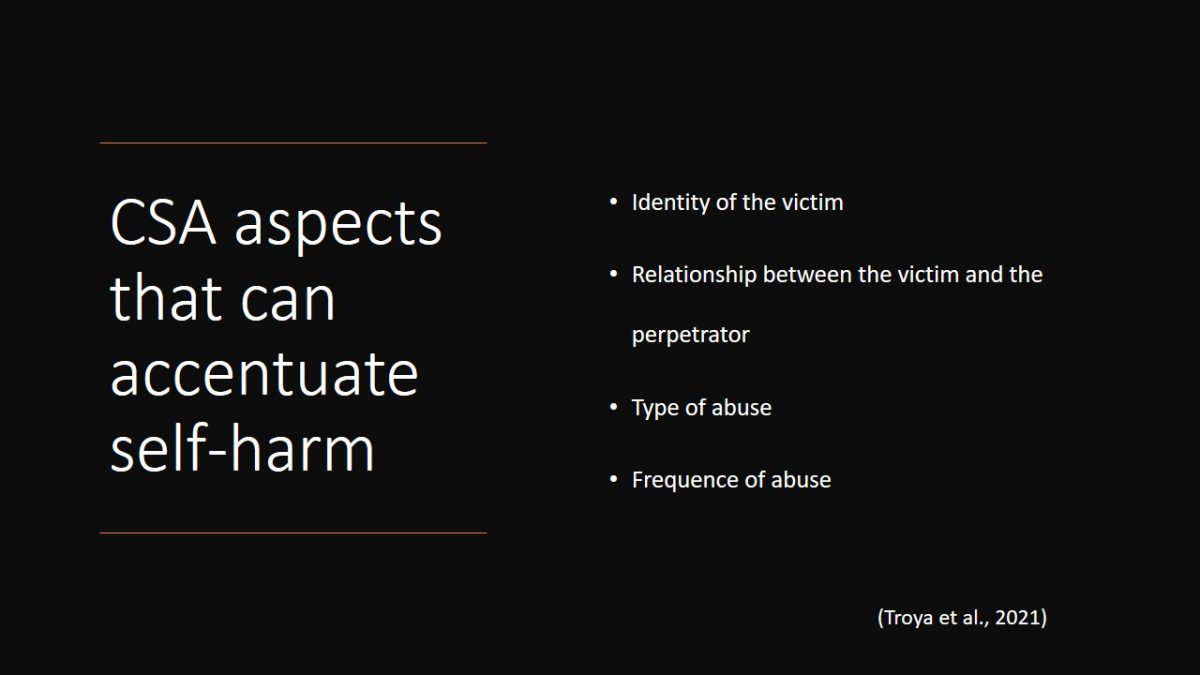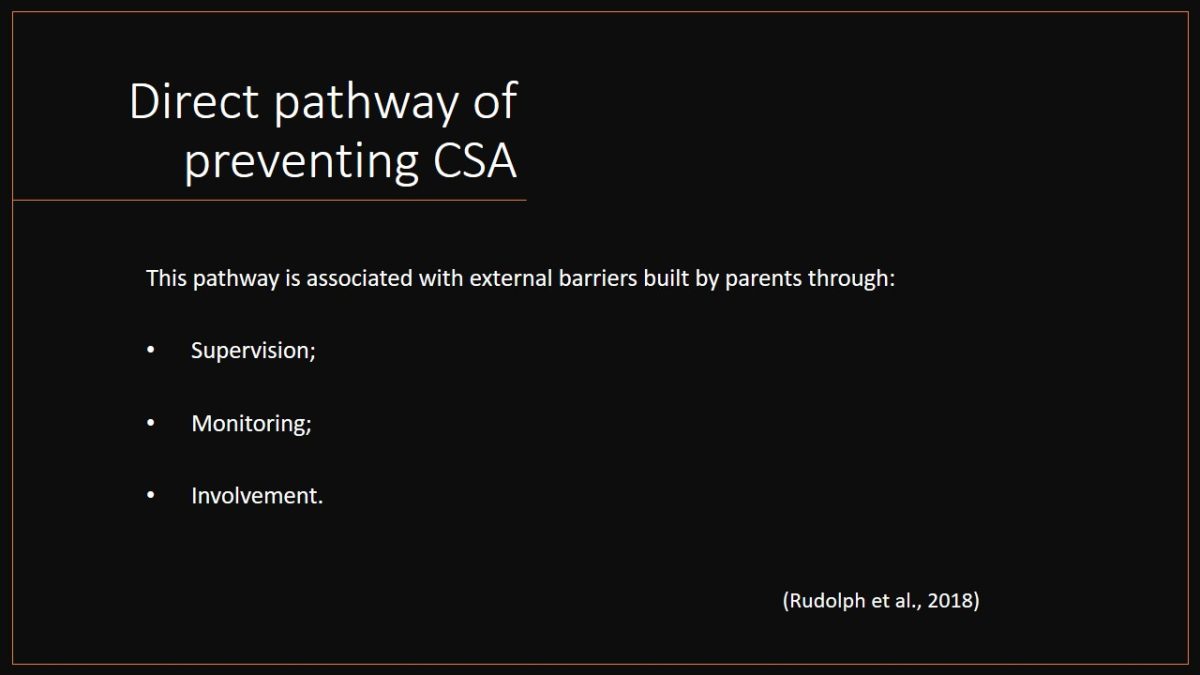The definition of Child Sexual Abuse
Sexual activity is considered Child Sexual abuse, if:
- A child does not fully comprehend it;
- A child is unable to give informed consent to it;
- A child is not developmentally prepared for it;
- It violates the laws or social taboos of society.
Many researchers provide different definitions of child sexual abuse in their studies. The World Health Organization (WHO) defines Child Sexual Abuse (CSA) as “the involvement of a child in sexual activity that he or she does not fully comprehend, is unable to give informed consent to, or for which the child is not developmentally prepared and cannot give consent, or that violates the laws or social taboos of society.”

Forms of Child Sexual Abuse
- Fondling.
- Inviting a child to be touched or touch sexually.
- Intercourse.
- Exhibitionism.
- Involving a child in pornography or prostitution.
- Luring a child online by cyber-predators.
Child sexual abuse is a variety of sexual activities that an abuser can perform. These include fondling, sexual touches, intercourse, and exhibitionism. Forcible or fraudulent actions that aim to involve a child in prostitution or pornography, as well as online luring, are also considered sexual abuse. All the activities mentioned above are illegal even if a child has given their consent to it, especially if that consent is uninformed.

Child Sexual Abuse and related Psychopathology
According to thematic studies, sexual abuse in childhood may lead to various mental health conditions in the future. The minds of children and adolescents are often unstable and weak, which is why they can be highly susceptible to different psychic disorders. Therefore, incidents of child sexual abuse can cause childhood trauma that may negatively affect the future life of a child or even lead to a severe mental illness.
Potential psychopathologies
- Depression.
- Anxiety.
- Post-traumatic stress disorder (PTSD).
According to recent studies, child sexual abuse is associated with different psychopathologies after the incident. These include developing depression, anxiety, and post-traumatic stress disorder, or PTSD for short. The researchers state that the victims of child sexual abuse are at increased risk of obtaining the mental illnesses mentioned above. Therefore, CSA can be dangerous for children’s mental health because it can lead to a severe mental condition in adulthood.

Abuse characteristics
- Type of abuse.
- Onset.
- Severity.
- Duration.
The researchers claim that the risk of psychopathology depends on specific characteristics of abuse. These include the type of abuse (physical or sexual), onset (age at first victimization), severity, and duration since some cases involve long-term abuse. Thereby, victims of child sexual abuse demonstrate vastly divergent outcomes in their mental health in adulthood. Specific sets of abuse characteristics may lead to different mental disorders in the future.

Onset significance
Most studies divide childhood into three developmental periods:
- Early childhood.
- Childhood.
- Adolescence.
There are three childhood developmental periods – early childhood, childhood, and adolescence. Recent studies suggest that younger victims cannot keep their negative situation under control like older victims. Thus, they have fewer chances to prevent potential abuse from occurring. Younger victims are also at higher risk of obtaining a mental health condition after the incident of sexual abuse. Moreover, the researchers report that earlier onset is associated with more severe symptoms of depression, anxiety, and post-traumatic stress disorder.

Self-harm and suicidality
The most recent studies suggest that there is an association between child sexual abuse and self-harm. As was described in the previous section, CSA can lead to various mental illnesses. In many cases, it also becomes a reason for self-harm. That is extremely dangerous for victims because those at risk of self-harm repetition are also highly susceptible to suicidal ideation.
CSA aspects that can accentuate self-harm
- Identity of the victim.
- Relationship between the victim and the perpetrator.
- Type of abuse.
- Frequence of abuse.
According to recent studies, several aspects of child sexual abuse can accentuate self-harm. First, it concerns the victim’s identity because some people are more fragile on a mental level, therefore, more susceptible to further self-harm in case of sexual abuse. Then, relation to the abuser matters as well; for instance, if the perpetrator is a close person of the victim or a family member, it would be much more harmful to them. Type of abuse (sexual or physical) and its frequency can also impact the possibility of self-harm in the future. For example, violent treatment may convince the victim that physical harm is normal. That, in turn, can lead to self-harm in case of failure or as self-punishment.

CSA secrecy: why a sexually abused child may keep it a secret
Victims of child sexual abuse often prefer to conceal it for the following reasons:
- Feelings of shame.
- Fear.
- Self-harm occurrence.
Victims of child sexual abuse do not always speak about it to their parents or someone else for specific reasons. First of all, it concerns feelings of shame, as children may feel ashamed of what happened to them, thereby they do not want anyone to know about it. Another reason is fear, since many children would never speak about such an occasion because they are afraid of punishment or the perpetrator has threatened them. Moreover, self-harm events also impact because if there are any traces of self-harm on a victim’s body, they would rather conceal the fact of sexual abuse. All the reasons mentioned above are critical because an incident of CSA is not something that children can manage on their own.

Suicidal intentions
“Identification of patients at risk of self-harm repetition is key for suicide prevention.”
The researchers state that people who have been sexually abused in childhood are at higher risks of obtaining suicidal ideation, primarily because of self-harm that follows the incident of sexual abuse. As described in the previous section, many victims of CSA are either afraid or ashamed to seek help in this situation. That can potentially lead to more self-harm; then, the victim’s thoughts may become suicidal because it is difficult to live with such an experience without outside help. Therefore, if a victim of sexual child abuse do not receive any support and cannot manage it, they are at high risk of suicidal intentions.

CSA Prevention Opportunities
The best possible outcome in case of potential child sexual abuse is preventing it from happening. For now, several opportunities to do it are available, and most of them rely on the corresponding education of children. Nonetheless, researchers are trying to explore innovative approaches to preventing CSA that can be more effective. The following slides demonstrate different pathways for parents to protect their children.
Direct pathway of preventing CSA
This pathway is associated with external barriers built by parents through:
- Supervision;
- Monitoring;
- Involvement.
Parents need to observe their children if they want to protect them, especially if there is a potential risk of child sexual abuse. Strong parental involvement in children’s lives is the first step to preventing CSA. Therefore, parents need to speak to their children, know who they communicate with, and understand their relationship with other people. After all, parents play the role of protectors of their children, and it is their primary duty to prevent such incidents as child sexual abuse from ever happening.

Indirect pathway of preventing CSA
Indirect pathway of preventing CSA involves promoting certain qualities in children, such as:
- Self-esteem;
- Self-efficacy;
- Competence;
- Well-being.
Aside from parental protection, children can do many things to protect themselves and prevent an incident of child sexual abuse. Adequate levels of self-esteem and self-efficacy and proper competence and general well-being may help children avoid becoming targets of CSA. In this case, they can also give an appropriate response and disclose sexual abuse if that occurs. Moreover, if a child feels they have become a potential target of CSA, they would immediately inform their parents, carers, or teachers and seek support and protection. Thus, children who are educated in such a way are less likely to become victims of child sexual abuse.

Development of CSA prevention programs
The researchers suggest that they can further improve the current CSA prevention program. However, to achieve that goal, they need:
- More evidence of the effectiveness of thecurrent methods of preventing CSA;
- A better understanding of parental behavior related to CSA protection;
- To create and assess new innovative approaches to decreasing the risk of CSA.
Many researchers agree that the current ways of preventing CSA have limited effectiveness due to the overreliance on child-focused interventions. The authors of the reviewed article believe that there are ways to move forward and improve the CSA intervention programs and make them more effective. That is an important goal since it is vital to prevent as many incidents of child sexual abuse as possible.

Other consequences and possible reasons for CSA
Aside from the impact that child sexual abuse may have on children’s physical and mental health, there are other consequences of that, including social ones and economic ones. Moreover, social and economic factors may work reversely and cause child sexual abuse in some cases.
Events that can cause CSA
- Low socioeconomic status.
- Social and economic pressures.
- Lack of food.
- Loss of shelter.
- Natural disasters.
According to recent studies, many external factors can influence the risk of child sexual abuse occurring in the family. The researchers report that low socioeconomic status leads to social and economic pressures and may cause more frequent child abuse, including sexual violence. Additionally, natural disasters can work in the same way: people experience a shortage of food. They often lose their homes, and that makes them more violent to children, especially in a sexual way.

The economic impact of CSA: Societal perspective
Costs of CSA include:
- Health care costs;
- Productivity losses;
- Child welfare costs;
- Crime costs;
- Special education costs;
- Suicide death coasts.
According to the research conducted in the United States, child sexual abuse can have a severe economic impact since it is associated with many different expenses. The researchers estimate the annual losses to CSA as much as 23 billion U. S. dollars.

Conclusion
Child sexual abuse is a matter of severe concern that is associated with:
- Various psychopathologies;
- Self-harm;
- Increased suicidal rates;
- Social problems;
- Economic consequences.
Summing up, child sexual abuse is a highly significant issue. Its victims not only suffer physically but may experience severe mental health disorders in the future. Moreover, they become susceptible to repeated self-harm and consequent suicidal intentions. Child sexual abuse may have a critical economic impact and cause severe monetary losses. However, these issues are actively studied by the scientific community. They seek new innovative approaches to prevent child sexual abuse and decrease the number of its victims.

References
Adams, J., Mrug, S., & Knight, D. C. (2018). Characteristics of child physical and sexual abuse as predictors of psychopathology. Child abuse & neglect, 86, 167-177.
Choudhry, V., Dayal, R., Pillai, D., Kalokhe, A. S., Beier, K., & Patel, V. (2018). Child sexual abuse in India: A systematic review. PloS one, 13(10), 1-32.
Letourneau, E. J., Brown, D. S., Fang, X., Hassan, A., & Mercy, J. A. (2018). The economic burden of child sexual abuse in the United States. Child abuse & neglect, 79, 413-422.
Rudolph, J., Zimmer-Gembeck, M. J., Shanley, D. C., & Hawkins, R. (2018). Child sexual abuse prevention opportunities: Parenting, programs, and the reduction of risk. Child maltreatment, 23(1), 96-106.
Seddighi, H., Salmani, I., Javadi, M. H., & Seddighi, S. (2021). Child abuse in natural disasters and conflicts: a systematic review. Trauma, Violence, & Abuse, 22(1), 176-185.
Troya, M., Cully, G., Leahy, D., Cassidy, E., Sadath, A., Nicholson, S., & Arensman, E. (2021). Investigating the relationship between childhood sexual abuse, self-harm repetition and suicidal intent: Mixed-methods study. BJPsych Open,7(4), 1-9. Web.